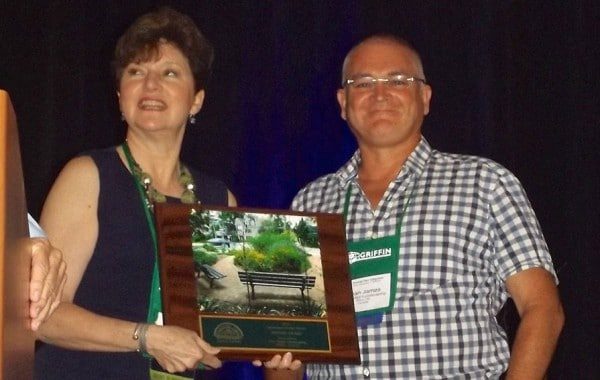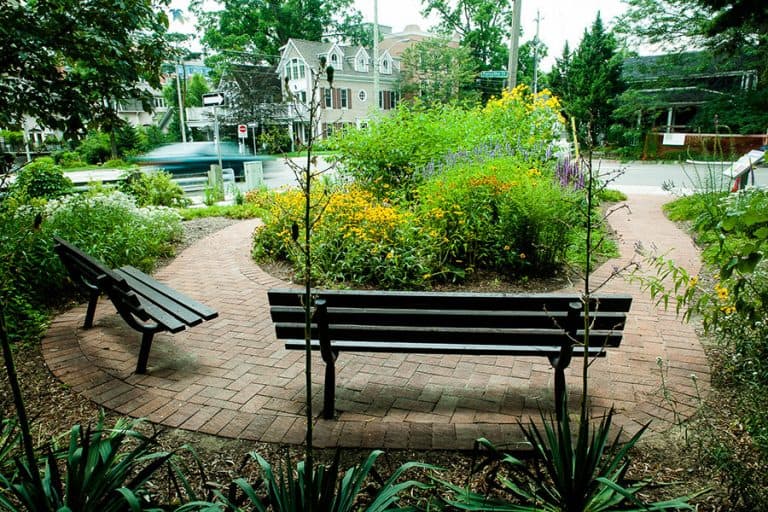
A public garden in Oakville, Ont., and the landscaper who designed it, have been given special recognition by the U.S.-based Perennial Plant Association (PPA). Sean James of Fern Ridge Landscaping in Milton, Ont., was on hand in Minneapolis for the annual PPA symposium to receive an honour award in the landscaping category. Only five of these awards were made in 2016 by the PPA, a trade association of growers, retailers, landscape designers and contractors, educators, and others who are professionally involved in the herbaceous perennial industry.
In making the award, the PPA emphasized the increasing importance of biodiversity-focused gardening throughout North America as well as the exceptional work involved in the garden.
The Anderson Parkette Biodiversity Garden was spearheaded by Kathy Kavassalis, co-president of the Oakville Horticultural Society, with help from the Town of Oakville and guidance from Conservation Halton.
“In 2010, the United Nations General Assembly challenged the world to take action to protect the great variety of life on our planet by safeguarding regional species diversity,” Kavassalis says.
“The garden now contains over 50 plant species native to North America,” Kavassalis says. “In the spring, painted lady butterflies flock to the pearly everlasting to lay their eggs and hummingbirds seek the delicate red columbines for their precious spring nectar (so important after their long journey across the lake). Rabbits start trimming the blazing star as it emerges, making the plants grow bushy and improving their stunning summer display of blooms. From our eastern bumblebee to the iridescent sweat bees and jewel-like syrphid flies, pollinators abound throughout the summer season. In the fall, goldfinches can be seen dangling from coneflowers as monarchs float from flower to flower preparing for their journey south. When winter comes, signs of mice and deer finding refuge can be seen. Bundled children sit on the bench and enjoy the beauty of grasses glazed with ice swaying in the chilly breeze. It is truly an oasis for life here in Oakville.”
Sean James designed the garden, entirely of native plants, to attract as many different species of life as possible, focusing on pollinators and other insects as well as birds. He say that any garden designed to provide a solution – such as a biodiversity garden, rain garden, edible garden or habitat garden – shouldn’t look like a solution, but rather be as beautiful as any other type of garden, if not more so, because of the different palette of plants that can be drawn from.


Learn more about the garden
Oakville Horticultural Society

PPA recognizes Garden Making editor
At its Symposium, the PPA also recognized Beckie Fox, Garden Making Editor-in-Chief.










Congratulations to Oakville Horticultural Society, they are a truly devoted bunch of gardeners. Sean James is one of the best and very talented in his field of design.
After reading all the information you posted about this wonderful garden, I would like to tell my Greater Toronto Rose & Garden Society about it. The only information I was unable to access was a most important plant list of natives used. It maybe my computer problem, but all other areas were available. After the drought this summer, I plan to seriously adapt my garden to more sustainable material!
As an aside, I have been a subscriber to your brilliant magazine from the first issue. (Just missing a few as they were lent out, not returned.) This email you send is most interesting. A go to every day!
I hope to see this garden this week. Thank you for your attention. Best regards, Iris
Where exactly is this garden? I would love to go see it.
According to the Oakville Horticultural Society website, the parkette is a 60×55 ft area at the corner of Rebecca and Forsythe streets that backs onto Sixteen Mile Creek. Here is a link to more information from the Oakville Horticultural Society.